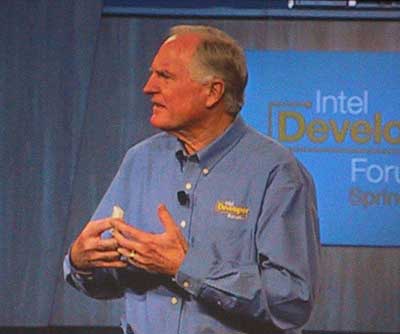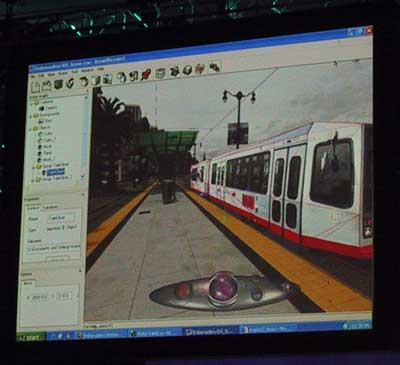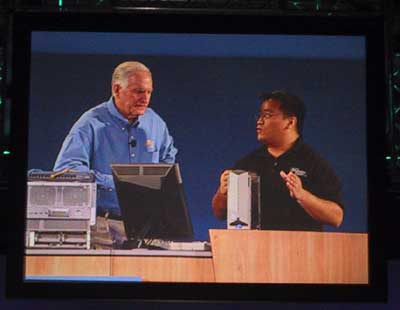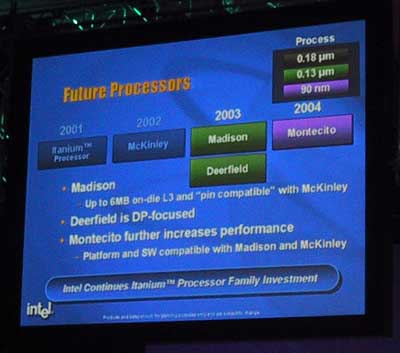
Original Link: https://www.anandtech.com/show/881
Intel Developer Forum Spring 2002 - Day 1
by Anand Lal Shimpi on February 25, 2002 5:53 PM EST- Posted in
- CPUs
For the past few Intel Developer Forum conferences the first day has always kicked off with some very impressive demonstrations. In years past we've seen the first air-cooled multi-GHz CPUs, we've had technologies like Hyper Threading introduced and we've had revelations about future CPUs like Banias. The first IDF of 2002 however started on a much different but well appreciated note.

Intel's CEO Craig Barrett began the first day of IDF with his thoughts on the economy and honestly I can say that his attitude and opinions regarding the future of the technology market are right on the ball. It's clear that Barrett has the right mindset to lead Intel out of the tough times that all technology companies are facing - we need to "innovate our way out of this recession."
This year's Spring IDF is by far the largest I've ever attended, with over 4000 attendees and over 50 countries represented. This caused the venue to be moved down to the San Francisco Moscone Center instead of its usual habitat in San Jose.
But of course you all came to read about the interesting demonstrations and not about the economy, San Francisco or the beauty of wireless internet access hotspots so let's get to it.
What do a 3GHz Pentium 4, a digital camera and the Matrix 2 have in common?
The first demonstration was one to show off a couple of technologies including software by a company called Realviz. Realviz happens to be invested in by Intel and thus the presence of their technology at IDF requires no explanation. The technology that Realviz has developed allows for a form of image based content creation.

The train in this picture is a 3D model generated from a digital photo using
a regular digital camera. Even more impressive is that the entire environment
is an interactive 3D world also generated from regular 2D digital stills taken
using a consumer level digital camera.
Using a digital still camera and the Realviz technology you are able to create a 3D world and 3D models from 2D digital still images. Imagine being able to take a bunch of pictures of an environment and stitch them together in a 3D world. This you'll know is already possible but the beauty of this demonstration was they actually created a 3D environment with actual 3D props also generated from 2D stills and made a movie out of them all. Using a few stills of Craig Barrett it was possible to create a fairly convincing 3D model of him on a snowboard tricking off of objects in a 3D world, all generated from digital stills. And of course all of this was done on an air-cooled 3GHz Pentium 4 processor.
This technology has apparently been licensed by Escape for use in some way with the upcoming sequel to the Matrix.
Some words on Technology
Mr. Barrett also had some things to say about forthcoming Intel technologies, talking about the future of CMOS transistors and even what lies ahead. As it stands, for the next 15 years Mr. Barrett saw CMOS transistors and CMOS based microprocessors to evolve to the following general characteristics:
- 2 billion transistors
- 30GHz clock frequencies
- 10nm (0.01-micron) transistors
- Processing power of 1 trillion instructions per second
- Built on 300nm (12") wafers eventually moving to 18" wafers and beyond
A quick video of Intel's D1C fab, the world's first 300nm - 0.13-micron manufacturing plant followed as we moved into the next demonstration.
Why would you need a 3GHz PC with 100Mbps Internet Access?
The final demonstration of Craig Barrett's keynote involved finding a real-world use for a 3GHz Pentium 4 with a 100Mbps Internet connection. Mr. Barrett has been spending quite a bit of his time lobbying for the US government to actually take broadband seriously. The idea is to have 100Mbps broadband access to homes within the next decade but ideally as soon as possible. But what would you possibly use that kind of bandwidth for?

The system on the left was the Xeon server, on the right is the concept Pentium
4 3GHz PC w/ Hyper Threading enabled
This demonstration used a 3GHz Pentium 4 concept PC (air-cooled) with Hyper Threading enabled (even more support for the fact that whatever replaces the Pentium 4 on the desktop will support a future-generation of Hyper Threading). A separate Xeon server fed 1080i HDTV content to this desktop PC which had no hardware HDTV decoding capabilities. In fact, the server fed not only one but two HD streams to the concept desktop PC which together ate up approximately 20Mbps of bandwidth. This demonstration alone would pretty much max out a 2GHz Pentium 4 or Athlon XP 2000+ but ran smoothly on a Pentium 4 3GHz machine with no stuttering.

The demonstration pushed the limits one step further by adding a third HD stream and mapping all three streams onto a rotating cube, eating up a total of 60Mbps of bandwidth and making use of close to 100% of the 3GHz CPU.

Once we all have 100Mbps Internet connections there will undoubtedly be other uses of that sort of bandwidth but HD streaming is going to be one of them. The types of Tivo and Replay TV devices that will be able to spawn given that type of internet access & CPU power will be impressive to say the least.
Continued Support for Itanium
As we've mentioned in the past, Intel isn't going to be dropping Itanium or IA-64 anytime soon in spite of the misconceptions that are floating around. As a testament to their commitment to the technology, Intel was a bit more open with some of the future IA-64 products that will replace Itanium:

McKinley - The successor to Itanium is pretty well known already. McKinley has been in pilot systems since late last year and is already running at 1GHz. The CPU has a 3MB on-die L3 cache, an 8-stage pipeline, 2 additional issue ports more integer and load/store units, finally the CPU will have a 128-bit FSB running at 100MHz quad-pumped.
Madison - The move to 0.13-micron will occur in 2003 with Madison which will feature up to an incredible 6MB L3 cache located on-die. Madison will be pin-compatible with McKinley.
Deerfield - Also based on Intel's 0.13-micron process, Deerfield will have less L3 cache than Madison and will be aimed at the entry-level IA-64 market in dual processor configurations only. Deerfield will also be made available in 2003.
Montecito - In 2004 we'll see the first 0.09-micron IA-64 processor from Intel codenamed Montecito. Very little is known about it other than the fact that it will have improved architectural features while maintaining platform & software compatibility with McKinley and Madison/Deerfield.







